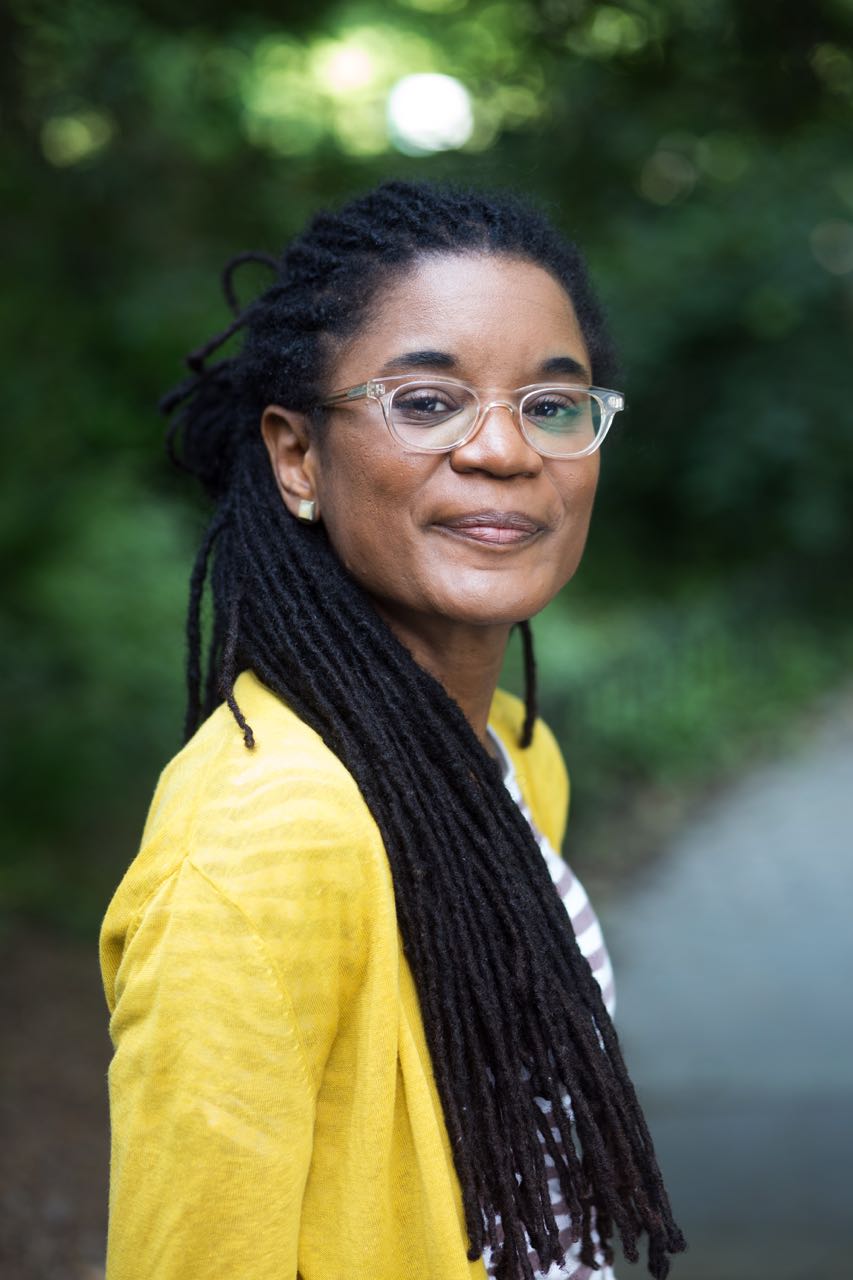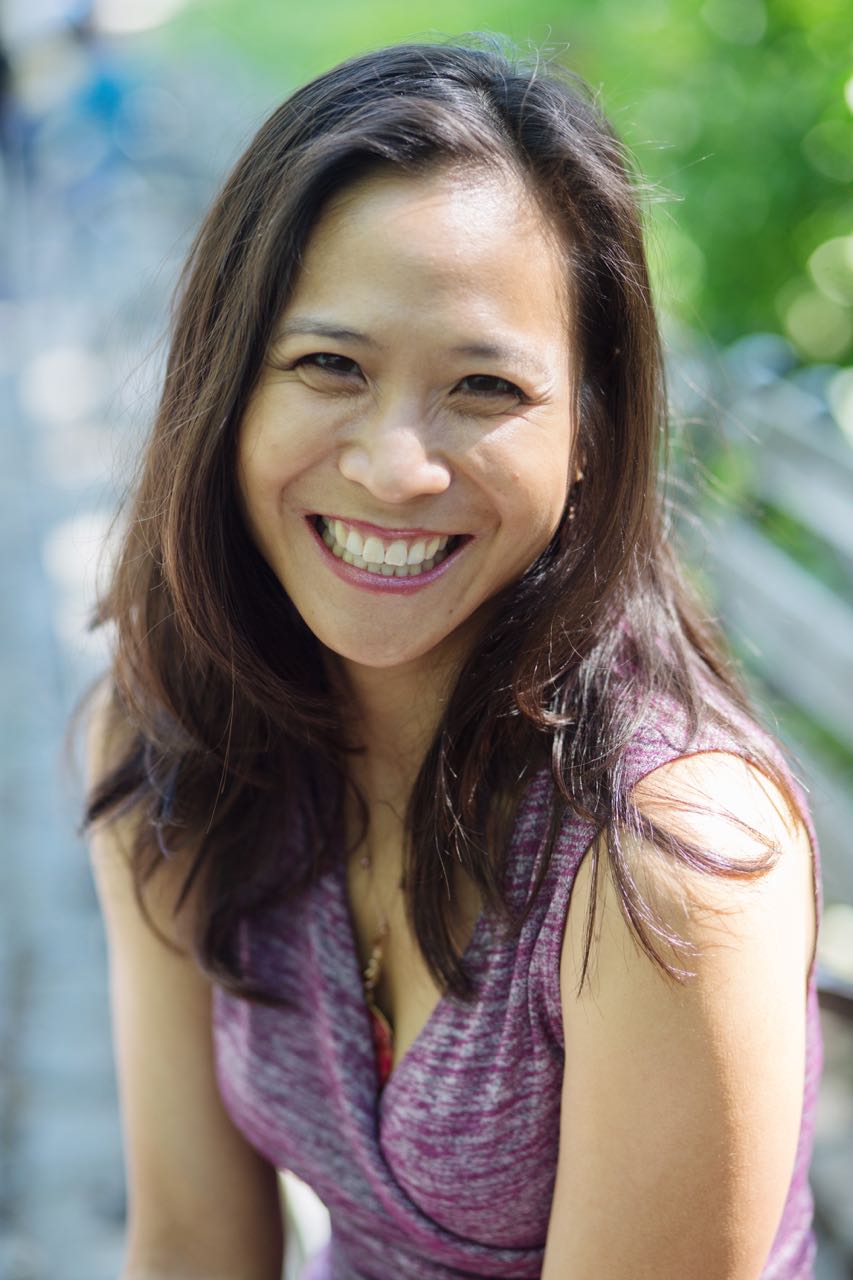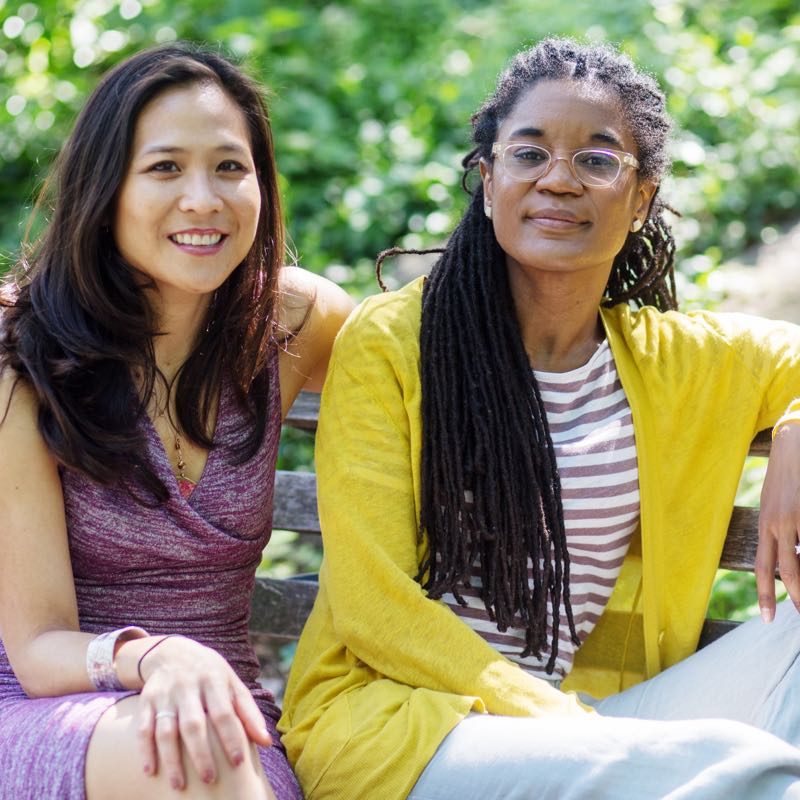May Adrales and Chisa Hutchinson on “Somebody’s Daughter”

Written by Victoria Myers
Photography by Tess Mayer
June 7th, 2017
The new play Somebody’s Daughter at Second Stage chronicles a period in the lives of three women that forces them all to make major decisions about who they are and who they want to be. At the center is Alex, a high-achieving high school student with an unhappy life at home, and two female role models in her life: her mother, Millie, and her school guidance counselor, Kate. Throughout the play they, along with external events, push and pull on each other in a way that adds a new dimension to stories about high school girls. We recently sat down with playwright Chisa Hutchinson and director May Adrales to discuss their process for writing and staging the play.
Chisa, what was your inspiration for the play?
Chisa: I read an article some years back about a trend among Asian-American families either aborting female fetuses or performing sex selection procedures in favor of boys, particularly if they already had a daughter, which I found really disturbing. It made me think about all these girls that I used teach back in southern California at this swanky private school where there were all super smart kids, and among them would be these really talented, super high-achieving Asian girls, and they were the quietest, most withdrawn, really shy, and not outspoken at all. That didn’t compute for me because where I was raised and how I was raised, if you were one of the top achieving students or could speak four languages and took all the AP exams, then you had every right to brag and walk around with your chest pumped out. This was confusing for me. It didn’t really make sense until I read that article. I wanted to write a play that honored their experience and draws attention to that kind of toxic family dynamic.
May, when the play came to you, what were your initial reactions and your way into it as a director?
May: There were a lot entry points for me with the play. I’m one of four girls in my family. I’m not Chinese American, but Filipino American. Still, the same preference for boys in the culture is really widespread. I felt immediately I understood where the play was coming from. I’m a huge advocate of Chisa’s work because I feel like she really gets to really powerful social issues through very alive and vibrant characters. I saw a lot of my childhood in the play. [The character of] Alex speaks four different languages fluently. I don’t do that, but I play three different instruments. I grew up in that sort of Asian, “be an overachiever” kind of family. I see a lot of myself in the play. It’s a directorial challenge, too. There are a lot of challenges in the staging of it. That’s always really fun for me. Also, getting opportunities to have other Asian-American women in the cast is a plus as a director.
What were your initial conversations like about how you wanted to put it on stage, both in terms of the themes of the play you wanted to pull out, but also the practical challenges like the many locations, or time shifting back and forth?
Chisa: It’s a story about three women. It’s three stories intertwining. We were pretty clear of the vision that it’s basically an ensemble piece, and I want to communicate that. I try to communicate it in the writing by giving them each as much stage time as possible. Then May came at me with some brilliance about if there’s a scene playing, out there [upstage] would be a background scene happening that isn’t necessarily written into the script. May just wanted to draw attention to the fact that while this is happening the other women are still living.
May: The play moves very fluidly and it has a very propulsive rhythm going forward. I knew we wanted to keep everything in motion. I wanted to give a strong inner life to all three of the women, and so they are on stage a lot. One of the things thematically is that each of the women is from a very different times and place, and they all are struggling with many of the same issues. Each one is coping with them differently, and they could all, in some ways, have become each other. The young girl could become her mother, or she could become Kate, the guidance counselor. Kate probably had a mother that was very similar to Millie, and could’ve become like her, but became something else. I wanted to show all of that in staging.
Chisa: That, and we have the tiny space.
May: There’s no wing space or fly space. There’s no nothing.
Chisa: Having half the cast on stage at all times is as much a practical decision as it is a thematic one.
Did anything else influence that? It reads as kind of cinematic or novelistic.
May: It is very cinematic, so I did want to make the staging very cinematic. There’s always something going on in the background and the foreground. I’m always trying to bring something into focus, but you already have the landscape, and so that definitely influenced the staging.

You have the three different women in the play and they kind of represent different types of women. What was your process for sculpting, shaping, and subverting that?
Chisa: My grandmother’s Japanese, but for all intents and purposes I’m a black woman. I move through the world as a black woman and people treat me as a black woman. I really wanted to not rely on stereotypes or just write the Asian woman as one particular kind of woman. There are as many ways to be Asian as there are Asians. The three women are all sort of coming out of this gender bias in very different ways. There’s Kate, who’s rebelling against it and doing everything that she can to sort of resist it and fly in the face of it. Then there’s Millie, the mom, who’s more traditional and has sort of fallen in line. Then there’s the young girl, Alex, who’s straddling both and trying to figure out what she wants to do with all that baggage. It was important to have that multiplicity of approaches to the issue. First of all, not all Asian women have this baggage. Second, if they do, then they don’t carry it the same. I just felt that it was important to give as much nuance to the women as possible, particularly because they’re Asian and not just because they’re women.
May: I see them all as three individual people with very specific circumstances. Certainly, what Chisa’s writing is a very specific case of a particular family who has elected to have a gendercide happen in the family. The process of any play that I work on is just really understanding what the circumstances are and trying to mine that.
Chisa: I actually had kind of a hard experience with writing it. When I started writing this script, it was really hard for me to not make them generic. I started writing this actually as my thesis piece at NYU. My class was really helpful. [The character of] Kate, for example, was super milquetoast. She didn’t really have much of a personality.
May: Oh, that’s hard to imagine.
Chisa: I know, right? Then my classmates at NYU were like, “Girl, get your life together. Infuse this girl with some energies or something.” I was like, “Oh, yeah. All right.” Then I put it in my head, “Just write her the way you would write a black chick.” So I wrote her the way I would write a black chick. Kate is pretty much black except when she starts talking about race. Then the other character that I really struggled with was Millie, the mom, because I think it’s easiest for her fall into the trap of severe tiger mom, to make her the familiar villain. People have been working really hard to make her sympathetic, to make her motivations clear and add some complexity, really come at her with some understanding of how one arrives at this point of abusing your daughter and pushing her all the time.
When you’re writing, do you see the play as a play?
Chisa: I see it as just in real life. I don’t really think about how to stage a thing. I don’t think, “Oh, they have to do a costume change, magically, somehow, in between these scenes.” I’m like, “Yeah, whatever. The director, the designers will handle that.” That’s kind of how I get into trouble. Directors who work with me I think get frustrated but also welcome the challenge.
May: Also, you’re so open. What’s made it easier for me is—I was able to look at the script, and you kind of give the director and the designers freedom to actually just make decisions about what the world is going to look like. It’s really generous.
Chisa: I actually do try to leave room for other people’s visions. It’s a collaborative art.

What was your process like for working with the designers and coming up with the world?
May: Lee Savage was the set designer and we’ve worked together multiple times. We really struggled because the theatre has a lot of parameters that we had to work around. There are 32 different transitions in the play and multiple locations. And the piece really needs to move. I knew that the most deadly thing would be to actually watch people move furniture on and off stage. You really want to just get wrapped into these women’s stories. We had three different meetings that were each like two hours long where we actually storyboarded through everything and a lot of different scenarios. We had three different models that we worked in. We were trying to go through the play and trying to see how everything moved. Then I kind of cracked it open that we need to have all three of these women on stage for most of the time. That somehow opened up our imagination to figure out what the whole landscape was. The other thing that is helpful is we are looking at these real people and we wanted to give as much insight into them as possible. I knew it couldn’t just be a representation of a kitchen. We had to, in some ways, have real stuff. We knew that we had to have a locker there, and…
Chisa: …and food. So much food.
May: You needed to have these realistic things where you couldn’t go in a more stylistic way. With all of that, I felt like we finally had this like breakthrough, and then we just started storyboarding everything. It was tough going at first. It almost felt like storyboarding a film because everything was sort of mapped out in my mind about how the whole thing moved. It wasn’t just the design of what we’re seeing on stage. To me, the design is really how everything moves on stage.
How did you work on balancing the realism of the piece with the theatrical metaphor that goes on, especially in some of the moments that are heightened?
May: I was trying to play with time, in a way, because the piece does play with time. The guidance counselor scenes, which we’re going back in time to, are actually more informed when you know what happens in the future for Alex. Those lines land differently. It’s what’s so brilliant about the structure of the play. There was a lot of talk about how to represent that. In order to make the time shifts clear, we did employ a lot of lights and sound just to develop a coherent language for that so it would be clear.
Did you find content dictating form for the time jumps?
Chisa: I honestly don’t even remember consciously making that decision. Well, at the end of the very first scene in the guidance counselor’s office—which is not actually the end of that scene because you keep coming back to that scene—the first part of that scene ends with such a show stopper that it didn’t feel right to just continue on with that scene. I was like, “All right, well, let’s just go to the guidance counselor’s house and see what the fallout is from hearing that or having that experience.” Then I just kept writing forward, but I kept wanting to come back to guidance counselor’s office just to see how that encounter kept playing out in their lives. I guess it just sort of organically happened. I didn’t go into this thinking, “Yeah, I’m going to frame it up. I’m going use this one scene to punctuate all the other scenes.” It’s all really instinctual.
May: I’m kind of churning over in my head this question about having three women that are of Asian descent and the politics of that. It’s one of the reasons I want to do more plays like this—it feels to me like this is a unique story. Somehow the question is only brought up when it’s people of a specific ethnicity. I find this a lot with a lot of Asian pieces that I work on: there somehow has to be a very firm reason to exist. It’s for a larger political act. It’s sort of a burden. I feel like the play itself is political because most theatre is political, but you also just want to focus on these three particular women. I’ve just been dealing with it a lot with the other plays that I work on. I’m going on a tangent.
There are two big things that happen to Alex in the show, and in terms of shaping those moments, which are very big, how do you do it in a way that is both realistic and serves the story?
May: I feel like that’s always the struggle. I think keeping the humor alive is a big part of it, because sarcasm plays a role in a lot of the scenes. Kate and Alex sort of diffuse tension by making a joke about it. That’s very human, and it also keeps it from getting into a sort of escalation, like life is almost too overwhelming to deal with. I think just being grounded in the humor, and trying to keep that real and the circumstances real. It’s definitely something that the actors and I have been working on a lot.
Chisa: We had these talkbacks, which I find nerve-wracking, but there was an audience member that was like, “Oh, but did you have to be so hard on her?” Or something to that effect of like, “Why the hardship?” I’m like, “Nobody watches plays about happy-ass people living happy-ass lives.” Nobody watches that. You come for the drama. You come to see bad shit happen to good people, in a way. You want things to go as easily for certain characters as possible, but that’s just not right. That’s just not how things go down. Certainly not on stage or in a theatre, because nobody’s coming to see that play. This is when it pays to have a really awesome director who can finesse that shit and not draw so much attention to the fact of, “Oh my God, [here’s a] big dramatic moment.” I mean it is a big dramatic moment, but it’s not melodramatic.
Tell me a little bit more about how you two work together. I know each writer-director relationship is different.
May: It’s easy when you totally adore the other person. We worked together on another show before, so that was actually good. It wasn’t our first time in a rehearsal hall together. I really love Chisa’s sense of theatricality and I love how deeply she understands these characters. There’s a lot of respect for the work and for Chisa, and then to figure out what her intentions were and how I can bring myself to it. It’s been so fun.
Chisa: It helps actually that this self that you bring to it is an enhancement. There are some directors who are so determined to do whatever the playwright’s vision is that they’re like, “I’m going to take that and I’m going to translate it so that the audience knows what that is.” Then there are directors who are like, “This is a great start.” They look at the script like, “All right, but how can we enhance the vision?” May is one of those directors. I don’t trust a lot of people to do this, but she will come at me with a suggestion for a change or say, “Oh, I think we’re going to try this. Would that be okay?” She’s very respectful about it and knows how to talk to a writer so as not to induce panic. It’s always in this spirit of experimentation like, “I think this could make it better,” and really wanting to serve the play. I feel in good hands with her. I’ve had some experiences with some directors who were a little more unilateral about their shit. I don’t really appreciate that. She’s so smart and thoughtful, and the brain that she brings to the play really does a lot to add dimension.

As you’ve started doing press for the show, is there anything that you wish people were talking about with it that they’re not?
May: You know, the play doesn’t wrap up neatly. Oftentimes the question will come of, “Why does it end this way? Why isn’t everything tied up?” I feel like Chisa is challenging that sort of structure. In a lot of ways she’s challenging that “well made play” structure. My favorite answer to that question is, “Well, life doesn’t wrap up neatly.”
Chisa: Because then you die.
May: What I think is really fantastic about the play is that it beckons other questions about these people’s lives, and I hope that people leave thinking about that. What’s been really inspiring is people leave the theatre and I’ll hear them talking about what happens next to the characters. I think that’s really exciting. There’s not been I time I left the lobby and people weren’t like, “Well, I think that she does this after.”

